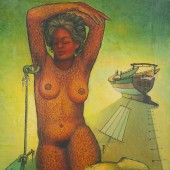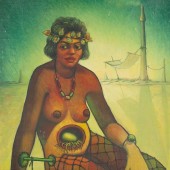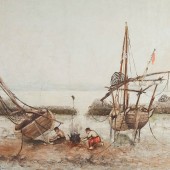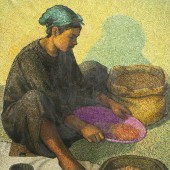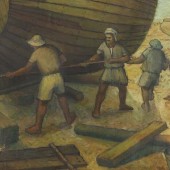Abdullah Al Qassar
- Country: Kuwait
- Exhibitions:
- Lines of Subjectivity: Portrait and Landscape Paintings
- Re: Orient
- The Short Century
A pioneer of Kuwait’s modern art movement, Abdallah Al Qassar is well known for his depictions of scenes that draw on Arab culture and heritage, particularly as they relate to Kuwaiti fishing life on the Arabian Gulf.
Al Qassar’s technique is captured brilliantly in the 1968 painting, 'Tandeef Alhinta.' An anonymous portrait, the work arrests a moment in time: a young boy shifting grain. The simplicity and solitude of the repetitive task is conveyed by Al Qassar’s perspective, compositional simplicity and colour palette. Covering the surface of the canvas are Al Qassar’s signature swirling, seemingly interconnected lines, which create an all over pattern that infuses his compositions with a dynamic sense of depth and movement. Similarly, Al Qassar deploys light and shade to suggest a sense of perspective.
It is this combined use of colour and line that mark Al Qassar as one of Kuwait’s most-technically versatile artists, one who began exhibiting in during the late 1950s. In 1962, he continued his training at Cairo’s School of Fine Arts, spending nearly a decade in Egypt after receiving a scholarship from the Kuwaiti government. Upon returning to his home country, Al-Qassar served as the treasurer of Kuwait’s Free Atelier from 1971 until 1982. He participated in more than 50 exhibitions throughout the Arab world and Europe.
Related artists by country
- Ibrahim Ismail
- Jafar Islah
- Mahmoud bin Radwan
- Abdul Rida Baqer
- Khalifa Al Qattan
- Mohammed Shaibany
- Khazaal Awad Qaffas
- Ayoub Hussein
- Issa Saqer Al Khalaf
- Munira Al Kazi
- Sami Mohammed
- Farah Behbehani
- Adel Al Khalaf
- Mohammed Al Kouh
- Thuraya Al Baqsami
- Dana Al Jouder
- Ala Younis
- Alymamah Rashed
- Aseel AlYaqoub
- Omar Al Nakib
- Sabiha Bishara
- Tarek Al Ghoussein
